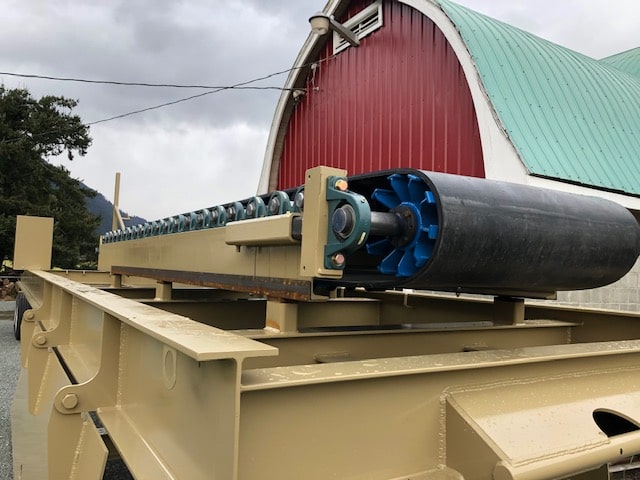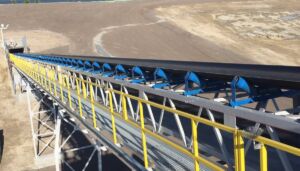Mining conveyors, crucial for moving rock, ore, or aggregate, are significant investments. Regular maintenance and avoiding unnecessary repairs are essential to minimize costs. While conveyor belts are typically designed to endure harsh conditions, component wear is inevitable.
You can employ a few effective maintenance strategies to extend the life of mining conveyor components and save on repair costs.
Understanding Mining Conveyor Belt Systems
Mining conveyors efficiently transport vast quantities of raw materials with minimal effort from your workforce compared to truck fleets. They comprise durable, sometimes fire-resistant belts powered by electric or gas motors.
Conveyor gearboxes transmit power to the system, which is crucial for handling heavy loads at consistent speeds. Typically, these gearboxes are designed to be robust and suitable for unique mining challenges.
The longevity of mining conveyor parts like rollers, idlers, pulleys, motors, gearboxes, scrapers, transfer chutes, and conveyor belts is vital. Proper component selection and maintenance can prolong their life.
Rollers and idlers are essential for smooth movement and support, and they face wear from dirty belts or bearing issues. Proper lubrication and suitable bearings can extend their lifespan.
Pulleys, with appropriate lagging and regular lubrication, can last a decade or more. Using ceramic lagging, especially for abrasive materials, can further enhance their durability.
Well-maintained scrapers keep the belt clean, reducing wear on other components.
Proper alignment of rock boxes and transfer chutes is crucial for depositing materials correctly and extending belt and idler life.
Extending the Lifespan of Your Conveyor Belts Components
Cleanliness and Lubrication
Keeping the conveyor system clean is essential for its long-term function. Regularly clear away debris, dust, and spills from the belt and components to avoid material build-up, which can increase friction and wear. Also, it’s important to lubricate bearings, pulleys, and other moving parts as per the manufacturer’s instructions. Proper lubrication reduces friction and heat, prolonging component life.
Add Accessories To Enhance Efficiency
Consider integrating additional accessories to enhance conveyor efficiency, such as Luff’s High Moisture Seal polymer disc. This innovative disc, designed by Luff Industries, stays static in the end cap while the roller turns around. Our design is particularly effective in high-humidity or wet environments, preventing material accumulation and ensuring smooth roller rotation.
Appropriate Belt Tension
It’s vital to maintain the proper tension in the conveyor belt. Excessive tension can overstrain the belt and cause early wear, while too little tension may lead to slippage and alignment issues. Regular tension checks and adjustments are necessary. For specific guidelines on the correct tension, refer to the manufacturer’s instructions or consult Luff Industries for tailored solutions.
Routine Inspections
Regularly checking your conveyor system is crucial for the early detection of potential issues, preventing them from turning into significant problems. Look for wear indicators on the conveyor belt, like cracks, fraying, or irregular tension. Ensure the belt is correctly aligned, and inspect rollers, pulleys, and bearings for any signs of damage, misalignment, or unusual noise. Early identification of these problems allows swift intervention and reduces the risk of further damage.
Preventive Maintenance Program
Establish an all-encompassing preventive maintenance strategy for your conveyor system. This plan should include regular tasks like belt cleaning, lubrication, tension monitoring, and component checks. Set a schedule and assign responsibilities to ensure consistent execution of these tasks. A well-maintained preventive maintenance routine can help in proactive issue resolution, reducing downtime and enhancing the lifespan of your conveyor belt and its components.
Replacing Worn or Damaged Parts
Be diligent in spotting worn or damaged parts during inspections. Replace any components showing significant wear, cracks, or other damage immediately. Delaying replacements can lead to more severe issues, such as belt slippage or complete system failure. Keeping a stock of spare parts on hand ensures quick replacement when necessary.
Employee Training
Operators and maintenance staff must be well-trained in handling and maintaining the conveyor system. Your team should understand the significance of routine inspections, cleanliness, and lubrication and be encouraged to report any irregularities immediately. Knowledgeable personnel are essential in early problem detection and maintenance, contributing to the system’s durability.
Custom Solutions and Maintenance from Luff Industries
Luff Industries provides expert guidance in choosing and maintaining the right components for mining conveyors, ensuring cost savings through reduced downtime and prolonged component life. When your conveyor belt is used for heavy-duty applications, you need to know that it’s durable and high-quality. We offer support for our clients with maintenance services, accessories, and other solutions to reduce operational costs and minimize downtown.




